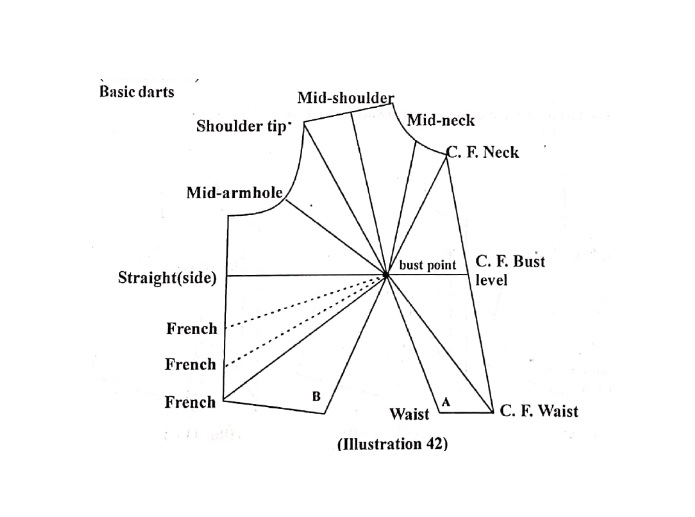The Dart Manipulation Principle allows for darts to be transferred to any location along the outline of a pattern from a specific pivotal point, without altering the size or fit of the garment. The excess fabric resulting from darts can be utilized in various ways such as gathers, pleats, tucks, and style lines, and can be hidden in the armhole or flare. Dart excess can also be split into multiple darts, styled as dart equivalents or combined in unique ways to achieve different design effects.
To transfer dart excess from one location to another for design variations, pattern makers employ techniques such as slash and spread and pivotal transfer. This is just the beginning of the pattern manipulation process, which requires both technical and artistic skills to control and manage the pattern throughout its development.
By using the Dart Manipulation Principle, pattern makers have the flexibility to create unique and innovative designs, providing more options and creative control in the fashion industry. With this principle, designers can create garments that fit perfectly and look stunning, showcasing their creativity and skill. Heights Fashion Institute Jaipur are provides the Best Fashion Design Courses in Jaipur.
Basic dart locations: To establish common areas for dart relocation and design detailing, a series of guidelines are drawn on a traced copy of the basic bodice front pattern. However, it is important to note that darts can be transferred to any location around the pattern's outline, and these guidelines are not the only options available.
When the excess fabric resulting from darts is transferred to the center front bust or the shoulder, the space between the dart's legs may vary. This difference is due to the distance between the bust point and the pattern's edge where the dart is placed. Despite this variation, the fit of the garment remains unchanged, as the number of degrees contained between the legs of the dart remains the same.
For practicing the slash and spread and pivotal transfer pattern making techniques, as well as design detailing, the charted working pattern should be used. This includes the basic dart locations shown in Illustration 42, but pattern makers can also explore other dart locations and variations to achieve their desired design. Heights Fashion Institute Jaipur for the Best Fashion designing in jaipur.
1. Waist dart
2 Center front waist dart 3. Center front bust dart
4. Center front neck dart
5. Mid neck dart
6. Mid shoulder dart 7. Shoulder tip dart
8. Mid armhole dart
9. Straight side seam dart
10. Also 10 (i) and (ii)-French Dart (French dart is anywhere on the side seam below the Straight side - seam dan location).
Dart Manipulation:- The slash and spread technique is a method of manipulating patterns to form new shapes. To utilize this technique, a traced copy of the original pattern is used and the original is never altered. The pattern is slashed, cut, and manipulated to achieve the desired new shape. Once the pattern is slashed and spread, it is placed on another piece of marking paper, retraced along the newly shaped lines, and the original discarded. The newly shaped lines are blended and seam allowances, grain lines, and other pattern details are added to complete the pattern.
In single dart control garments, the dart should end approximately one-half inch from the bust point to provide room for the round shape of the bust mound. To manipulate a pattern, all slash lines leading to a pivotal point or stitch line must be cut to, but not through it. The slight connecting part, called a hinge, keeps the pattern intact as it is spread or overlapped. If all slash lines are not cut to a pivotal point or stitch line, the pattern cannot be manipulated effectively.
By utilizing the slash and spread technique, pattern makers have the ability to create unique and innovative designs. This technique provides more options and creative control in the fashion industry, allowing designers to showcase their creativity and skill in garment construction.





Comments